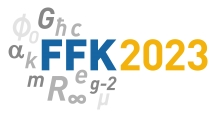Speaker
Description
Collaboration
Benetti M. (Napoli), Bentum M.-J. (Eindhoven), Bonetti L. (Orléans), Capozziello S. (Napoli), dos Santos Filho L.R. (Rio de Janeiro), Ellis J. (CERN London), Helayël-Neto J.A. (Rio de Janeiro), Lämmerzahl C. (Bremen), López-Corredoira M. (La Laguna), Mavromatos N.E. (CERN London), Perlick V. (Bremen), Randriamboarison O. (Orléans), Retinò A. (Paris), Sakharov A.S. (CERN), Sarkisyan-Grinbaum E.K.G. (CERN), Sarracino G. (Napoli), Spallicci A.D.A.M. (Orléans), Vaivads A. (Stockholm).
The Standard-Model Extension (SME) induces a mass to a photon [1,2], the only SM free massless particle. Observations of Fast Radio Bursts [3-5] and solar wind plasma [6,7] allowed estimates and limits listed in the Particle Data Group reviews. SME, classic (de Broglie-Proca and others) massive and non-linear electromagnetism theories (Born-Infeld, Heisenberg-Euler and others) determine a frequency shift of the photon in presence of a background, with which it exchanges energy [8]. This shift, added to expansion red shift, determines new cosmological scenarios, e.g., without recurring to the accelerated expansion to explain Supernovae data [9-11]. The upper limit of this shift would be 7.7x10-27 Delta f/f per metre which implies 2.9x10-18 in Delta f/f for an interferometer simulating the Earth-Moon distance. Finally, we apply the Heisenberg principle in the energy-time form to cosmological scales and read the Hubble constant as quantum measurement [12,13].
[1] 2017, Phys. Lett. B, 764, 203
[2] 2018, Eur. Phys. J. C, 78, 811
[3] 2016, Phys. Lett. B, 757, 548
[4] 2017, Phys. Lett. B, 768, 32
[5] 2017, Adv. Space Res., 59, 736
[6] 2016, Astropart. Phys., 82, 49
[7] 2022, arXiv:2205.02487 [hep-ph]
[8] 2019, Eur. Phys. J. C, 79, 590
[9] 2021, Eur. Phys. J. C, 81, 4
[10] 2022, Eur. Phys. J. Plus, 137, 253
[11] 2022, Eur. Phys. J. Plus, 137, 1386
[12] 2020, Found. Phys. 50, 893
[13] 2022, Found. Phys. 52, 23

